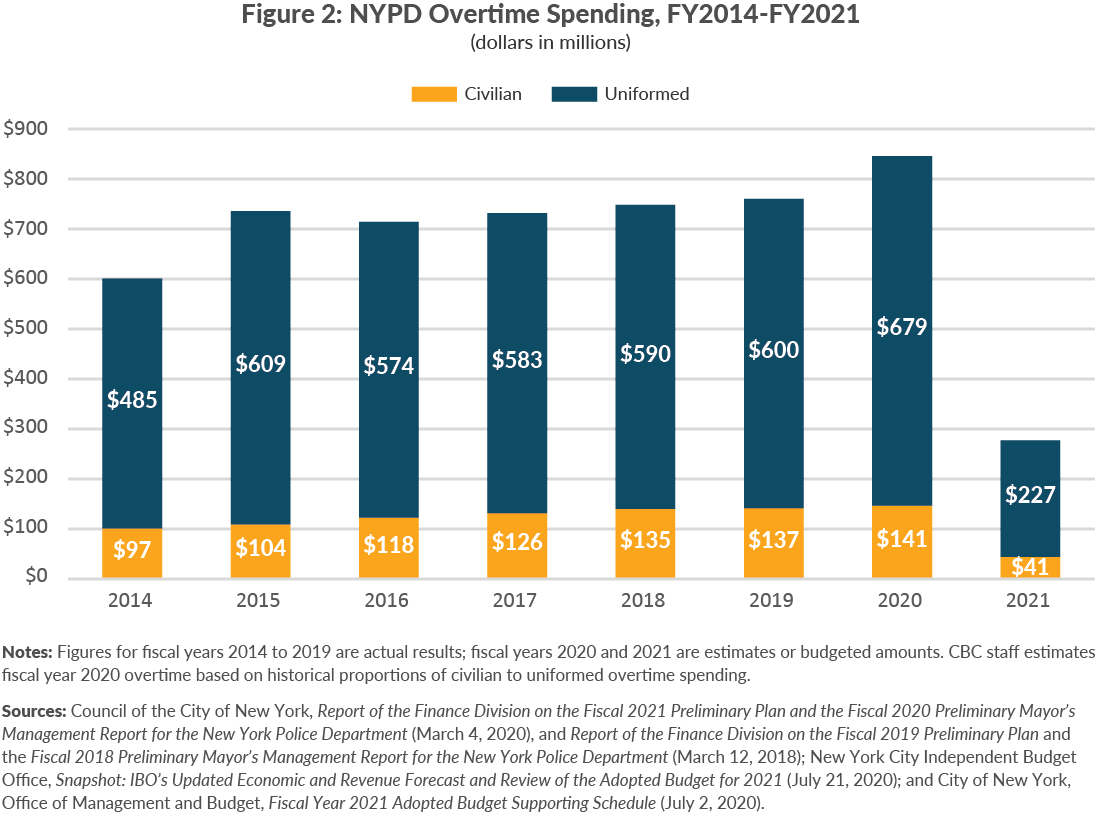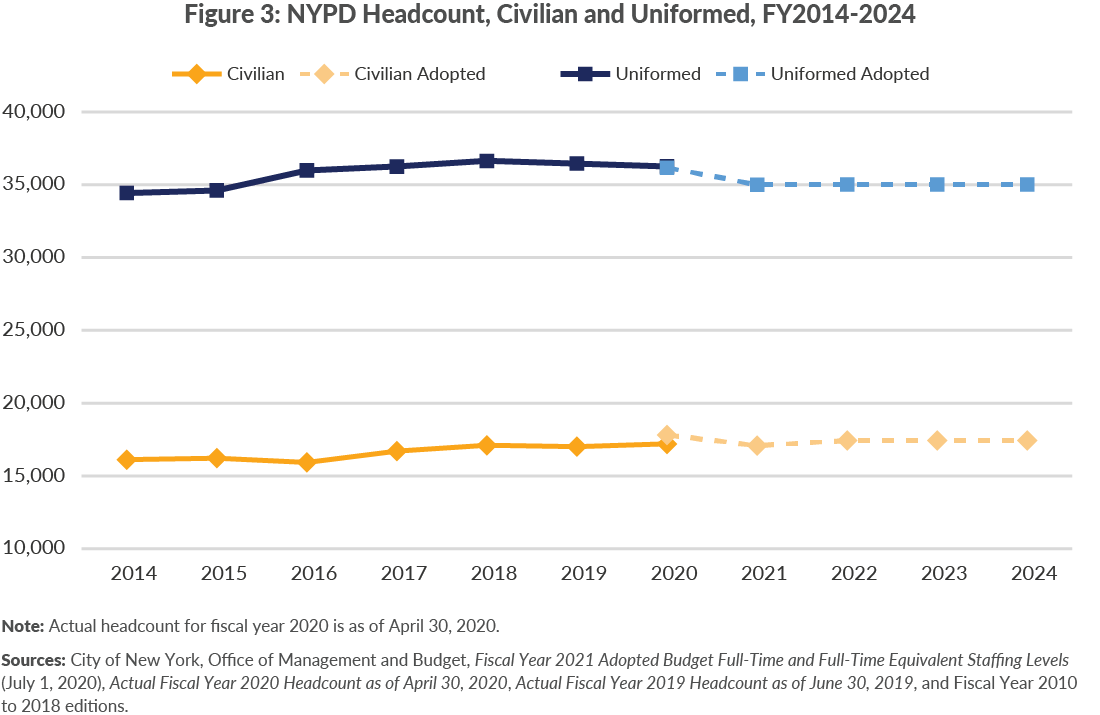Was the NYPD Budget Cut by $1 Billion?
The size of the New York City Police Department’s (NYPD’s) budget was a prominent focus of this year’s budget negotiations, with many activists and elected officials calling for a $1 billion cut. City funding for the NYPD is projected to decline by $282 million from $10.5 billion to $10.2 billion between fiscal years 2020 and 2021. The operating budget will decrease by $345 million, or 6.6 percent, from $5.2 billion in fiscal year 2020 to $4.9 billion in fiscal year 2021.
The cut is larger, $474 million, when measured against the Executive Budget for Fiscal Year 2021. Most of it is from an unrealistic one-time reduction in overtime expenses. The recurring reduction to the operating budget is $82 million annually, mainly from reductions in hiring.
Budget Reduction Between Fiscal Years 2020 and 2021
In fiscal year 2020 the NYPD budget, including both the department’s operating budget and central expenses, totaled $10.9 billion. Most of this—$10.5 billion—was funded directly by City taxpayers and is comprised of the $5.2 billion operating budget directly controlled by the Police Commissioner and central expenses of $5.3 billion (payments for fringe benefits and debt service) that are managed and budgeted for on a citywide basis. (See Figure 1.)
The Adopted Budget for Fiscal Year 2021 appropriated $10.2 billion in City funds to the NYPD—an operating budget of $4.9 billion and central expenses of $5.3 billion.1 The agency City-funded operating budget is projected to decrease by $345 million, or 6.6 percent, from fiscal year 2020. This year-to-year decline is greater than the 3.6 percent agency average. Some smaller agencies had larger proportional declines, including 13.1 percent ($58 million) at the Department of Parks and Recreation and 24.0 percent ($169 million) at the Department of Youth and Community Development.2

Budget Reduction Against Previously Planned Spending
City leaders used the Executive Budget for Fiscal Year 2021 as the baseline for measuring “cuts” to the NYPD. The Executive Budget proposed a $10.7 billion NYPD City-funded budget in fiscal year 2021, which was reduced by $474 million in the Adopted Budget. (See Table 1.) Fully 75 percent of the reduction, or $354 million, is in overtime expenses. Another $81 million in savings comes from cancelling the July Police Academy Class.
In total, the NYPD’s City-funded expenses are 4.4 percent lower than planned in the Executive Budget. The operating budget was reduced 7.8 percent ($415 million) and central expenses were reduced 1.1 percent ($59 million).
The Mayor’s press release announcing the changes to the NYPD budget also reported an agreement to shift responsibility and funding for school safety agents and crossing guards to the Department of Education (DOE) for a total of $350 million.3 However, the Adopted Budget does not reflect these funding shifts, and they are not included here. A $4.5 million reduction for moving the Homeless Unit from the NYPD to the Department of Homeless Services, included in the budget, is reflected in this analysis.4

Overtime Reductions Are Not Realistic or Recurring
The budgeted overtime reduction amounts to a 56 percent cut to the fiscal year 2021 NYPD overtime budget compared to the Executive Budget, and a 67 percent decline from fiscal year 2020. (See Figure 2.) These savings are unrealistic; they were not accompanied by a plan or operational strategy, and prior efforts to reduce overtime at the uniformed agencies have been more successful in slowing growth rather than decreasing expenses. The Mayor’s Office contends fewer events (such as parades) will result in less overtime for officers; however, these events comprised 25 to 30 percent of all uniformed police overtime spending in recent years, meaning overtime reforms would need to be far-reaching and potentially negotiated with labor unions to achieve the steep reduction currently budgeted.5
In addition, these overtime savings are budgeted only for one year. As a result, the NYPD operating budget returns to $5.3 billion in fiscal years 2022 to 2024.

Recurring Savings are Due to Headcount Reductions
In fiscal year 2020 88 percent of spending at the NYPD was personal service costs (salaries and wages, including overtime). Most of the $82 million recurring cut reflected in the Adopted Budget is from headcount reductions attributable to cancelling the July Police Academy Class, freezing civilian hiring, reducing vacancies in Traffic Enforcement Agents, and moving the Homeless Unit out of the NYPD.
These four actions reduce the NYPD workforce by 1,404 positions– 1,171 uniformed and 233 civilian—in fiscal year 2021.6 (See Figure 3.) Uniformed headcount will decline to 35,030 through fiscal year 2024, which is still greater than the fiscal year 2014 headcount of 34,440.7 NYPD civilian headcount will grow to 17,446 in fiscal year 2024, larger than the civilian workforce in fiscal years 2014 through 2019.

Download Blog
Was the NYPD Budget Cut by $1 Billion?Footnotes
- Total, all-funds operating and central expenses for the NYPD is $10.228 in fiscal year 2021. This includes just $19 million in federal and state funds; these funds are traditionally recognized over the course of the year and are expected to increase. For example, during fiscal year 2020, the City recognized $460 million more in federal and state aid between June 2019 and June 2020. This excludes $307.7 million in intra-city funding. See: City of New York, Office of Management and Budget, Adopted Fiscal Year 2021 Budget Financial Plan Expense (June 30, 2020), https://www1.nyc.gov/assets/omb/downloads/pdf/adopt20-fp.pdf.
- CBC staff analysis of City of New York, Office of Management and Budget, Adopted Fiscal Year 2021 Budget Financial Plan Expense (June 30, 2020), https://www1.nyc.gov/assets/omb/downloads/pdf/adopt20-fp.pdf.
- City of New York, Office of the Mayor, “In the Face of an Economic Crisis, Mayor de Blasio Announces Budget that Prioritizes Safety, Police Reform, Youth Services, and Communities of Color” (press release, June 30, 2020) https://www1.nyc.gov/office-of-the-mayor/news/487-20/in-face-an-economic-crisis-mayor-de-blasio-budget-prioritizes-safety-police.
- Budget documents did not indicate any central expense savings due to the agency shift.
- Events were 25 percent of uniformed overtime in fiscal year 2016 and 30 percent in fiscal year 2017. See: Council of the City of New York, Report of the Finance Division on the Fiscal 2019 Preliminary Budget and the Fiscal 2018 Preliminary Mayor’s Management Report for the New York Police Department (March 12, 2018), https://council.nyc.gov/budget/wp-content/uploads/sites/54/2018/03/FY19-New-York-Police-Department.pdf; and Ana Champeny, Overboard on OT: Reductions in Uniformed Overtime Needed (Citizens Budget Commission, August 17, 2017), https://cbcny.org/research/overboard-ot.
- An additional 143 civilian positions will not be filled in fiscal year 2021 due to the cancellation of the Cadet class. However, this reduction is not recurring.
- Uniformed headcount will be below the fiscal year 2016 headcount of 35,990, which reflected the hiring of about 1,300 new police officers as part of the City’s community policing initiative and expansion of counterterrorism response capacity.